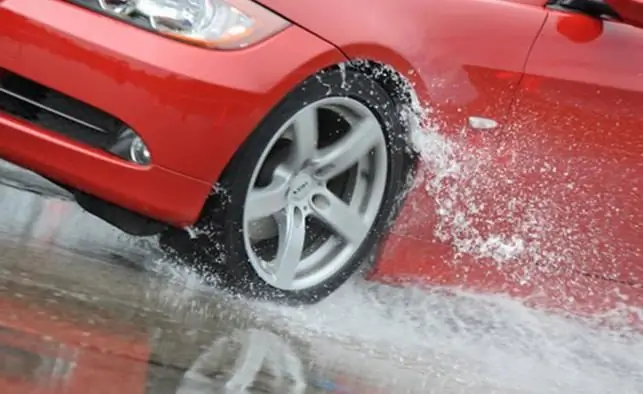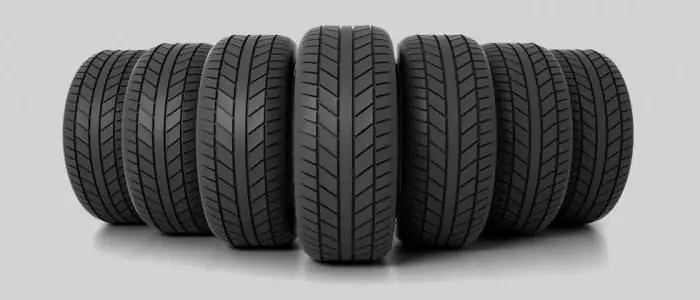2025 Author: Erin Ralphs | [email protected]. Last modified: 2025-01-22 21:14:12
Car tires consist of two main elements - tread and carcass. The latter takes on the main power loads. And this is not only air pressure from the inside of the tire, but also the unevenness of the roadway outside. In this regard, for its manufacture, a special rubberized fabric (cord) is used, which is located around the entire perimeter of the wheel in several layers. The basis of the cord can be cotton, nylon and viscose, but most often it consists of a metal wire (the so-called metal cord). In this case, the surface of the base (wire) is covered with a thin layer of brass, approximately 0.1-0.2 mm thick.

Compared to its counterparts, this design is the most durable and resistant to heat.
Car tires and their varieties
All tires that are installed on modern cars and trucks,fall into two categories:
- Radial.
- Diagonal.
A radial tire has special cord fibers with a diagonal bead connection direction. In this case, the inevitable crossing of their paths appears in adjacent layers of paint (see photo).

In this regard, the number of applied layers of cord must be even. Also, this type of tire is different in that the fibers connect the beads directly, heading towards them at an angle of 90 degrees.
Classification of radial tires
In turn, this type of wheel is divided into two more categories and can be both textile and combined. Both classes have a similar frame material. Most often it is synthetic nylon. Their main difference is the type of breaker. On textiles, it is made of synthetic fibers, and on combined ones, it is made of metal cord. It is this combination of materials that experts call optimal. At the same time, the strength of such a tire is significantly increased, and the likelihood of cracking on the rim and microprojector is reduced to zero.
Marking
All modern manufacturers of radial-type car tires designate them on the sidewall with the letter R. In the marking, it looks something like this: 180/75 R14. Very often, motorists confuse this symbol with the landing radius of the wheel. In fact, R14 speaks of a landing diameter, which in this case is equal to fourteen inches. Diagonal analogs are not marked with a similar symbol. In the tire size designationthere are only numbers (for example, 6.50-15).
Why are diagonal wheels a thing of the past?
Such wheels are currently practically not produced and are not installed on cars and SUVs. This is because diagonal tires undergo a lot of deformation in the tread area while driving. As a result, the grooves of the pattern are significantly compressed, and the protrusions begin to slip along the supporting surface. Due to this, the quality of their adhesion to the road is significantly deteriorating, and, accordingly, driving safety is at risk.
Advantages of radial wheels
Among the main advantages of this type of tires should be noted their ability to operate at high speeds and light weight. In addition, radial tires have a greater load-bearing capacity, are less exposed to heat and are more elastic in their structure than bias tires.

It should also be noted that, due to their low curb weight, these wheels are safer to use. In practice, vehicles with radial tires are more agile and stable at high speeds, with studies reporting excellent traction on both dry and wet roads.
Since the mentioned car tires (summer or winter - it does not matter) perceive only one type of load, the thread tension in the carcass is much lower than that of bias tires. This allows you to use fewer layers of material for the frame, due to whichthe quality of heat dissipation increases. By the way, each cord here is absolutely independent. Due to this, there is no need to cross the fibers of adjacent layers (hence we get a less expensive production). By the way, car tubes for tires of this type are not required. All of them are tubeless, and therefore are used on all modern cars.

It should also be noted that radial rubber allows the use of ultra-modular cord types for the production of a breaker. Thanks to this, excellent tread grip is obtained, as we have already mentioned earlier. And due to the rigidity of the breaker, the deformation of the tread is minimized, so the resource of such wheels is very large (at least on a flat road). At the same time, such a wheel is less vulnerable to punctures, and in fact on our roads you can often find construction nails, glass, and rusty screws.
Flaws
The operation of car tires has shown that the main disadvantage of such tires is their excessively high elasticity. And this does not apply to the entire tread, but only to its lateral part. If you drive frequently over bumps or ruts, this can cause damage to the wheel. For the same reason, the radial tire is very sensitive and demanding on the pressure inside the chamber. If this indicator is greatly underestimated, we should expect premature damage when hitting stones and curbs. Another disadvantage of such a tire is its high cost.
Application Features
By virtue of theirdesign features, the radial tire has practically replaced its diagonal counterparts, which can now only be found on trucks, from production. And even despite such a "bouquet" of shortcomings, in terms of their characteristics, radial wheels are far superior to competitors, and therefore are used on all types of modern vehicles.

So, we found out what features a radial tire is characterized by, how it is marked and where it is tried on. When considering all the advantages and disadvantages of these wheels, it becomes obvious that in the near future radial tires will completely displace their diagonal counterparts from the world market.
Recommended:
GT Radial Champiro IcePro tires - country of manufacture, specifications and reviews

Motorists often pay attention to Radial Icepro tires from the Giti Tire brand. What are they? What reviews can you find about GT Radial Champiro Icepro tires? All this and other important questions - below
Basic designations on tires. Designation of all-season tires. Explanation of tire designation

The article describes the standard designations on tires. A list of international designations with decoding is given
Tire index. Tire index: decoding. Tire load index: table

Car tires are like human shoes: they must match not only the season, but also the technical characteristics of the vehicle. The concept of "uncomfortable shoes" is familiar to everyone. The same thing happens with the wrong tires. One of the important indicators of rubber is the tire index, which determines the maximum load and permissible speed per tire
Is it possible to drive on winter tires in summer: safety rules, tire structure and differences between winter and summer tires

There are situations in which the driver can use winter tires in the summer. This refers to wheel damage on the road. If the spare wheel in the car is studded, it is allowed to install it instead of the punctured one and drive this way to the nearest tire fitting point. For such actions, traffic police officers do not have the right to issue a fine. But you should figure out how the rubber intended for another season will behave on the road
"Toyo" - tires: reviews. Tires "Toyo Proxes SF2": reviews. Tires "Toyo" summer, winter, all-weather: reviews

Japanese tire manufacturer Toyo is one of the world's top sellers, with most Japanese vehicles sold as original equipment. Reviews about tires "Toyo" almost always differ in positive feedback from grateful car owners

